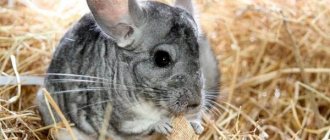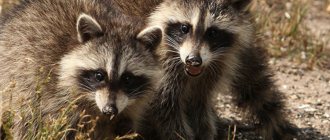Scientists continue to study these unique animals, because even today some facts about their life elude biologists. The animals are distributed throughout the world; the largest wolves live in Russia, Alaska and Canada. Several decades ago, the ancestor of the gray wolf was found. Its length was over 2 m, and its weight was more than 100 kg. Similar representatives of the canine family no longer exist, but its descendants are striking in their size.
Gray wolf
The largest representatives of the canine family live throughout North America and Eurasia, but the largest specimens of this species are found in Russia.
Their weight can exceed 100 kg, body length with tail up to two meters, height at the withers quite often exceeds one meter. Under natural conditions, life expectancy is 12–15 years.
Fluffy, dense fur visually increases size. The animal is capable of reaching speeds of up to 65 km/h. The color of the common wolf varies from gray-brown to ocher, depending on the habitat. In North America there are representatives of this species with black fur.
Wolves live in packs of up to 40 representatives. It is headed by a leader. He, like his female, are respected by other individuals. Wolf cubs are born blind and helpless; in one litter, from 3 to 12 cubs are born.
Interesting! A wolf's nose is 14 times larger than a human's. They are able to distinguish 200 million shades of smell, but humans can only detect 5 million.
Predators go hunting in the dark. Preferences in food are given to artiodactyls, but they can also be content with smaller animals, birds, and in some cases, carrion.
Tasmanian marsupial wolf
The second name, the thylacine, has been officially declared extinct, but scientists recognize the possibility that there are still a few individuals left in abandoned places in Tasmania. Previously, it was considered one of the largest predators among marsupials, the total body length reached 1.5 m, weight 20-25 kg.
The last thylacine died of senility in 1936. So far, no one has managed to catch or photograph a single individual.
If the wolf wanted to yawn, his jaw opened almost 180°.
polar Wolf
One of the rarest species among giant wolves lives in the vast Arctic, its body is covered with thick, dense snow-white fur, which perfectly protects from severe frosts and harsh northern winds.
The weight of representatives of this species varies from 65 to 85 kg, the height at the withers does not exceed 80–82 cm, the length without tail is between 130–150 cm. Life expectancy is about 7 years.
On barren plains covered with snow and ice, there are great difficulties in obtaining food. The main food source is hares, lemmings, reindeer, and musk ox. The wolves' bodies have adapted to go without food for a long time, but when luck smiles, they can eat up to 10 kg of meat at a time. Starving wolves often swallow hares along with bones and fur.
Polar wolves live and hunt in packs, the number of individuals in a group is no more than 25. Up to 5 cubs are born in one litter.
The number is decreasing every year. The cause of extinction is not only the impending global warming, but also poachers who are attracted to their beautiful fluffy fur.
Arctic wolves are listed in the Red Book; hunting them is strictly prohibited.
Melville Island wolf
Predators are most common in North America. The rather large wolf is slightly smaller in size than the previous species.
Its length is approximately 90–180 cm, height – up to 80 cm. Males are much larger than females, the difference in weight varies from 30 to 45 kg. Adult males can weigh 80 kg.
The color of the animals is light white, cream, occasionally with a gray or bluish tint. The belly is covered with white fur. Compared to other representatives of the canine family, the animals' limbs are quite short.
The Melvelian wolf has small, rounded ears. The further north they live, the smaller their ears are; this feature helps them retain heat.
Melville wolves can survive in difficult arctic conditions. Animals are perfectly adapted to cold weather and can endure even the coldest winters. In these parts, temperatures often drop to -50 °C.
It is quite difficult for them to find food; hunting does not always end successfully for predators. They often eat carrion. During severe cold weather, wolves hunt small animals; at other times, even moose become their target. An adult male needs about 5 kg of food per day. Representatives of this species unite in flocks of 7–10 individuals.
Wolves place their homes on rock ledges or inside caves. What distinguishes them from the rest is their strong attachment to their fellow creatures. Difficult climatic conditions influence their behavior; predators prefer to stay together.
New in blogs
Wolves have always played a very important role in human life. They were both sworn enemies and best friends of people. Giant wolves, whose weight is about ninety kilograms, are especially terrifying.
There are a total of 24 species of wolves of different sizes.
The Tasmanian marsupial wolf is considered the largest among marsupial predators. According to official data, the animal is extinct, but there remains hope that several individuals survived in the wild places of Tasmania. Without taking into account the tail, the length of this predator reached one and a half meters, and the height was about sixty centimeters. The weight of the individual was up to twenty-five kilograms. The large species include the maned wolf. It has other names - aguarachai and guara. Long hair adorns the shoulders and neck of these wolves. Its height is on average seventy-five centimeters, weight varies from twenty-one to twenty-three kilograms with a length of one hundred and sixty centimeters.
The largest marsupial wolf has long gone extinct
The Melville Island wolf is considered especially large. With a length of up to a meter and eighty centimeters, the weight can be about eighty kilograms. The objects of his hunt are musk oxen, reindeer, and moose.
The Melville Island wolf grows to almost two meters.
On Eurasian territory, the Central Russian forest wolf reaches its maximum size. The height at the shoulders can reach a meter, and the length sometimes exceeds a meter and sixty centimeters. The maximum weight of an adult male is almost forty-five kilograms. The Siberian forest wolf is practically not inferior in size to the Central Russian wolf when comparing average sizes.
Where do the biggest wolves live?
It is believed that the further from the equator wolves live, the larger they are. Thus, the size of wolves from the tropics is usually equal to the size of an ordinary dog, but wolves from Alaska, Canada and Russia are among the largest.
Ethiopian wolves are considered small.
They are the size of an average dog. The common gray wolf, recognized as the largest in the world, lives over a wide area in various landscapes. More often it can be found in forest-steppes, deserts, steppes, tundra and open mountain areas. But in dense forests this species lives less frequently. At one time, gray wolves lived over such a vast area that they conceded master rights only to humans. Today, the area of residence has been greatly reduced.
Large common gray wolves live in both deserts and tundra
Another largest wolf, the Melville Island wolf, lives on the North American continent on the Arctic islands and on the island of Greenland in its northern part. The wolf uses the natural landscape to construct its den. More often their homes are located in rock ledges, small depressions or caves. A rare polar wolf lives in the Arctic. Its living conditions are harsh, however, the predator managed to adapt. A polar wolf can go without water for several weeks, but after the first successful hunt, it can easily eat up to ten kilograms of meat. Due to sudden climate changes, the usual habitats begin to change, this leads to a significant reduction in the number of polar wolves.
What do giant wolves eat?
Wolves, regardless of size, prefer to eat their prey alive - often these are large ungulates that are driven by a wolf pack. The wolves pounce on the animal and tear it apart. The victims still remain alive for some time.
There are wolves that eat weak relatives
It is known that cannibalism is widespread among wolves; they eat wounded and sick relatives. Sometimes, in a mortal fight between two packs, alpha males die and are subsequently eaten by their own offspring.
It is known that the maned wolf most often hunts alone. Its prey is small animals: various birds, pacu and agouti. These wolves often carry poultry, and when gathered in a flock, they can attack sheep. The maned wolf does not disdain plant foods.
Huge wolves can also hunt livestock
The Melville Island wolf obtains food in a pack using driven tactics. Prey includes lemmings, moose, arctic hares, musk oxen, as well as large but weakened animals.
The largest wolf in the world at present
Gray predators these days have “matured” and grown a little. It is known that the ancestor of the modern wolf is Canis dirus, which became extinct during the Ice Age. The length of the individual was about two and a half meters and weighed one hundred kilograms.
anis lupus - the largest wolves on Earth
In the nineteenth century, a wolf was considered large, weighing between sixty and seventy kilograms. In 1939, in Alaska, a hunter shot a wolf weighing ninety kilograms, its length was about one and a half meters. According to unconfirmed reports, a wolf weighing more than ninety kilograms was killed by one of the hunters in Siberia.
The largest wolf on the planet is the gray wolf, Canis lupus. Its length, excluding the tail, reaches one meter and sixty centimeters, and its weight is about ninety kilograms. The height of the gray predator is ninety centimeters. Canis lupus is not only the largest wolf, but also the largest member of the canine family.
Eurasian (European) wolf
The most common subspecies of the gray wolf lives mostly in Europe and Central Asia.
The weight and height of wolves varies depending on the region. The largest reach a size of 74–76 cm and 69–74 kg at maturity. Such indicators are typical for males; female wolves are 10–15 cm lower and weigh up to 65 kg.
The body of the animals is covered with thick and short hair. The color of Eurasian wolves is quite varied. There are individuals of white, black, gray, red, light cream color. There are also individuals in nature that have a combination of colors.
Representatives of this subtype go hunting in packs. They mainly feed on medium-sized animals: deer, wild boar, mouflon, saigas. On European territory, the largest prey is considered to be the bison, and for the inhabitants of Asia - the yak. Predators do not disdain hares and frogs.
The largest wolf of this subspecies, weighing 72 kilograms, was killed in Romania.
In times of famine, alone, European wolves get closer to people. In search of food, they rummage through landfills and feed on food waste along with dogs.
Interesting facts related to wolves
Male and female
- The largest representative of the species, weighing 86 kg, was killed several years ago in Ukraine.
- In Korolev, near Moscow, there is a “Wolf House”. Here they rescue and rehabilitate wolves that have suffered at the hands of humans. In the future, the animals remain in the “House”, undergo training and become, as far as possible, tame. Excursions are regularly held on the territory of the “Wolf House”. Those who wish can walk with the wolf, take photos and listen to a story about the creation of this institution.
- Representatives of the species, in captivity, live up to 20 years. In the wild, the life of a wolf is short - 8-10 years.
- Gray wolves, in the last few years, have begun to come out to people more often. Villagers especially suffer in winter, when predators visit yards and destroy poultry, livestock, and sometimes dogs.
- Wolf cubs are born with blue eyes. The color changes when babies reach 3-4 months.
- “Wolf Song” is the most unusual and creepy phenomenon that a person can encounter. The lead singer is the alpha wolf, the male sings in a bass voice. The song is picked up by the “wife”, her voice is higher and thinner. Gradually, the voices of the other members of the pack are woven into the howl. Animals support one motive, high and very unusual. The impressions from the “wolf song” are creepy, but it fascinates with its harmony.
- Representatives of the species not only sing, they also communicate using howls. Thanks to this, members of the pack receive information: where everyone is, what this or that wolf is doing at the moment, whether danger is looming and whether there is potential prey on the horizon.
- Gray wolves have a rich facial expression and vocal repertoire. Animals howl, whine, growl, squeal and, sometimes, bark. It has been proven that the voices of wolves depend on the position they occupy in the pack. An adult male makes low, guttural sounds. Females, on the contrary, are more squealing and tall. Young animals whine subtly, and puppies grunt.
- If necessary, European wolves can pursue prey for a long time - up to 12 hours.
- Predators are familiar with the concept of hunger; many adult animals are able to withstand it for a week. The most interesting thing is that wolves do not lose body weight during this time and remain active.
- Moving away from danger, a flock can easily cover distances of 80-100 km. It would seem that there is nothing surprising in this, but predators travel many kilometers in one night.
- The maximum speed that a wolf is capable of is 80 km.
- Depending on the habitat, the diet of wolves can consist of large herbivores, small rodents, and bird eggs. If possible, the “gray barrel” will feast on a fox, raccoon or domestic dogs. In addition, in the warm season, voles and even locusts become prey for predators.
- Carrion is eaten extremely rarely, out of complete despair.
- Did you know that timber wolves are apple and pear lovers? Some individuals manage to eat wild berries and do it with pleasure.
- In captivity, wolves are fed beef, chicken or turkey, and offal. Gray predators will not refuse dried delicacies, for example, ox root, beef cheek, and pig ears.
- Among dogs, there is a breed of Czechoslovakian Wolfdog. The breed was developed in Czechoslovakia, in the middle of the 20th century, as a result of mating between German shepherd dogs of working breeding and Carpathian wolves.
- Wolves are monogamous. If a couple breaks up, the remaining “half” may die of melancholy. When a “loved one” is killed, the orphaned wolf or she-wolf begins to take cruel revenge. Now it is more difficult for them to find the killer, because hunters come to their bloody business from big cities. And before, village hunters did not often kill wolves, because the other half of the killed one came to the village, found the hunter’s house and, at best, destroyed the cattle along with the bird.
- Those who dream of a real wolf need to understand that this is a predator. Our ancestors had a saying: no matter how much you feed the wolf, he keeps looking into the forest. This is true, a wolf will never become completely tame, he is a wild animal with a corresponding character.
Rocky Mountain Wolf
The habitat of the largest individuals of the gray wolf subspecies is the northern Rocky Mountains of North America. Sir John Richardson was the first naturalist to identify this subspecies in 1829. He also gave the name to gray predators based on their main habitat.
The length of an adult wolf ranges from 66 to 81 cm, weight 32–68 kg.
The body is covered with a thick layer of beautiful light gray fur, the chest is white. A wolf pack contains 8–12 individuals, but sometimes larger families of up to 40 animals are found.
In the middle of the last century, the population of Rocky Mountain wolves declined greatly, and they were taken under protection. Thanks to the timely adoption of measures, the number of individuals increased after just a few years. In 2012, this subspecies was removed from the list of protected species.
Hardy and very strong wolves easily hunt large representatives of artiodactyls. The diet of Rocky Mountain wolves mainly consists of bison, musk oxen, deer, and bighorn goats. During hungry periods, predators can be content with squirrels, hares, beavers, and lemmings.
Mackensian plains wolf
This subspecies is one of the largest wolves in North America. Habitat - western parts of the mainland, the largest population is in western Canada, Alaska and central Idaho. There are 10,000 individuals of this subspecies in total.
At the withers, the animals reach 91 cm, although the body weight of wolves does not exceed 65 kg. The largest wolf of this subspecies was caught in Alaska in 1939, weighing 79 kg.
The fur of adults is very thick and fluffy. During the cold winter period, wolves are saved from the cold by their undercoat, which they shed with the onset of warm spring days. Coat color varies from white to black. The body of the Mackenzi plain wolf differs from other species in its proportional shape. Thick, muscular and rather long limbs allow them to move quickly over rocky terrain and not get stuck in deep snowdrifts.
Mackensian plains wolves have the largest and lightest paws of all representatives. The huge size of their lungs allows them to breathe deeply on the tops of mountains. Animals have a large reserve of energy, allowing them to cover 100–115 km per day.
The wolves of the Mackenzie Valley are not only among the largest in the world, but also, thanks to their luxurious thick “fur coat,” they are considered one of the most beautiful representatives of the canine family.
Wolves hunt mainly elk, reindeer, musk oxen, and bison. They choose prey among those who lag behind the pack or are exhausted. They pursue the victim one by one, waiting until the deer or elk gets tired and only then tearing it into pieces.
Giants of world history
The Guinness Book of Records does not contain recorded cases of wolf achievements, but there are plenty of interesting facts about them.
1. Kenai wolf. So, if today the gray wolf is considered the largest representative of the canine family, then until recently it was inferior to the Kenai wolf, and came into first place as a result of the extinction of this giant subspecies. On the Kenai Peninsula in southern Alaska in the 90s of the 19th century, gold miners encountered predators whose body length without a tail was up to 210 cm, and the length of the tail added another 60 cm.
Kenai wolf
The largest birds of prey
The weight of the animal reached 90-100 kg, and the height at the withers was 110 cm. The predators hunted elk. The animal was described in 1944 by American zoologist Edward Goldman based on the skull, since by that time large wolves were no longer found in nature - in the 10s of the 20th century, predators were massively poisoned with strychnine. Since the animal competed with humans and was considered dangerous, it was simply destroyed during the gold rush.
2. Tasmanian marsupial wolf. Separately, it is worth mentioning the Tasmanian marsupial wolf - this species also became extinct, remaining only in history. The last sightings of this predator date back to the 1930s, but there are still old stuffed animals in museums and private collections. The reason for the death of the marsupial predator population was Australian farmers, who considered the animals a threat to sheep flocks and poultry houses and exterminated them until 1914. The final point was brought about by the canine plague introduced by European animals.
Tasmanian marsupial wolf
Recent research by scientists has revealed that marsupial wolves did not deserve the fame of ferocious predators and simply could not attack sheep - the structure of their underdeveloped jaw allowed them to feed only on birds and lizards. This wolf is considered the largest among marsupial predators. The body length of marsupials weighing 20-25 kg reached 100-130 cm, the tail added another 40 cm, the height of the animal at the withers reached 60 cm. Due to the specific structure of the body with curved hind legs, the gait of the animal became galloping; if necessary, the animal could even jump on his toes like a kangaroo.
Due to the atypical appearance of the marsupial wolf, European travelers called it either a dog-headed possum or a tiger cat. Dense yellowish fur with dark stripes on the body, a gray muzzle, a head with round ears and a mouth that opened to 120 ͦ, bear little resemblance to the usual wolf exterior. Despite the official status of an extinct species, enthusiasts still have hope of meeting a marsupial wolf in the hard-to-reach jungle.
Canadian wolf
A resident of the North American continent is one of the largest subspecies of the gray wolf.
The size of the animal depends on its habitat. The colder it is, the larger the wolf. On average, the height at the withers is 60–85 cm, length 105–160 cm, weight 32–62 kg.
Incredibly fast predators, whose speed can reach 70 km/h, are considered one of the most dangerous animals. Game rarely manages to escape their tenacious clutches. Wolves unite in large packs, forever roaming the vast expanses. Occasionally they attack bears, coyotes and bison, but in most cases they prefer not to expose themselves and their fellow creatures to danger. Deer are the common prey of wolves. Alone, predators kill small animals; domestic animals often become victims.
Interesting fact! The wolf, whose weight was 105 kg, is the largest representative of this subspecies. According to scientists, he was the ancestor of the famous sled dog breed in Alaska - the Alaskan Malamute.
Initially, the species of the canine family lived in the south of the Rocky Mountains, in the western part of the states, in Canada. Subsequently, almost all representatives were killed, the wolves remained only in Alaska, and then migrated to Wyoming, Montana and Idaho.
Currently, hunting the Canadian wolf is strictly prohibited.
Great Plains Wolf
The most common species of wolf in America, numbering more than 3,700 representatives. Large populations are found in the central part of the mainland and Canada.
The Great Plains wolf is much larger than the common gray wolf. Predators grow up to one meter, their body length is about two meters, and their weight reaches 52 kg.
The coat color changes depending on the time of year. Closer to winter, the black and red coat turns white with a small amount of black spots at the tips of the coat.
Representatives of the subspecies live in small flocks (up to 6 individuals). In rare cases, wolves unite in packs of up to 30 pieces. Food for predators includes elk, deer, birds, and small species of mammals. Muscular giants go hunting at night. It is not difficult for them to catch up with a medium-sized animal; wolves of the Great Plains can reach speeds of up to 70 km/h.
In 1974, this subspecies was on the verge of extinction, but by 2004. the situation with the number returned to normal.
Great Plains wolves avoid people and never approach human habitations.
Behavior
Who is watching and who is sleeping
Perhaps the wolf is among the TOP smartest animals on the planet. It is enough to look at the organization of a wolf pack to be convinced of what has been said.
Let's start with the fact that a strict hierarchy reigns in the pack. A wolf “pride” is led by a male leader and his female, followed by the rest of the family. At the lowest level are wolves with weak character.
No one dares to claim the role of leader; the latter fiercely defends his place in the pack if such a situation arises. The exception is old age or illness of the leader, then the young wolves will do everything to overthrow him from the throne. Often, a sick leader is killed, and expelled much less often. The old male, on the contrary, is driven away and, after some time, he dies or is killed by the teeth of other predators.
Among she-wolves, there is also a division. The alpha female is the only one who is allowed to bear offspring. Her daughters, living in a pack, leave their parental territories at the time of the “hunt.” Pursued by young males from other groups, she-wolves often no longer return to their former pack, creating their own family with their chosen one.
What happens if one of the females who is not the leader of the pack becomes pregnant? Here the wolf laws are cruel: they expel her, or wait for the birth of the wolf cubs and destroy them.
Wolf packs are quite large, the number reaches 12-15 individuals. They include parents - leaders, offspring - young of the year and “children” born in the previous year.
Tundra wolf
Northern beauties reach a length of 140 cm, weigh on average 42–49 kg, and the height at the withers of adult individuals is 80 cm.
The main habitat is the Kola Peninsula, Kamchatka, and the taiga shores of the North Sea. Representatives of this subspecies are considered the largest wolves in Russia.
The body is covered with soft, very long and thick hair that protects from the cold. The coloring of most representatives is white-gray with dark splashes on the sides, head and paws, but pure white wolves are also found in nature.
They prefer to hunt in packs. If one of the members of the pack sees prey, he calls the others with the help of special sounds, and only then does the pursuit of the victim begin. Wolves of this species almost never live in one place. They follow packs of potential victims.
Their food preference is reindeer. Massive sharp teeth are capable of not only tearing apart prey, but also crushing the strong bones of large animals. In one meal, tundra wolves can consume 14 kg of meat.
Tundra wolves stay away from people and rarely come close to dwellings.
Red Wolf
The red wolf is considered a rather rare representative of predatory animals. Currently it is an endangered species. Found many times in central and southeast Asia. There is no reliable information about their origin. But presumably the ancestor is a marten. What makes it different from others is its bright red coat color.
Adults have a brighter shade, while older ones are pale. Can be seen in national zoos. They live well on rocks and in caves. They feed on small rodents, hares, raccoons, wild boars, and deer.
Mexican wolf
In terms of size, this subspecies does not occupy the highest positions among large wolves.
The body size of predators does not exceed 150 cm in length, height ranges from 68–77 cm. The weight of wolves is small, from 23–41 kg, the limbs are long and muscular. The combination of these parameters allows them to develop high speeds in mountainous terrain.
The color contains predominantly brown, gray and reddish tones, allowing the Mexican wolf to be almost invisible in the desert and among the rocks. A distinctive feature of the animals is a long thick mane.
Packs are not numerous, the number of individuals usually does not exceed 8. Wolves live mainly in mountain forests; there are burrows among plains overgrown with bushes. The diet is based on bighorn sheep, antelope, deer, rabbits, wild boar and small rodents.
The Mexican wolf is an extinct species. According to official data, the last representative of the subspecies was shot in 1960. Since the early 90s of the last century, the Mexican government has approved a program to revive the population in its former habitat.
Caucasian wolf
Medium in size, length ranges from 85 to 90 cm, males weigh 30 kg, females 25. The skin has rough and short hair, the underfur is not sufficiently formed. The color is dominated by a dull color with a grayish, dirty tint, the hardness of the coat is higher than that of the subspecies of the north.
Outwardly close to the wolf living in the Caspian lowland, with which it is easy to confuse it. Lives among the mountainous forests of the Caucasus and Transcaucasia, northwestern Iran, and some parts of Turkey. But it is also found among the steppes, for example, in Shirak.
Eastern wolf or North American
Size of the individual: body weight - 40 kg (female 30 kg), height of the male at the withers - 80 cm (female 75 cm).
The provinces of Ontario and Quebec are considered to be the habitat of the predators. Scientists have different opinions about the origin of the beast. Some call it a gray wolf/red wolf or coyote hybrid. Others conclude that they belong to a separate species.
The fur of the North American wolf is very thick and thick, mostly gray in color, with yellow or brown hairs sometimes visible. It is darker along the back and sides. Brown fur is visible behind the ears.
Wolves do not hunt in large packs; they usually do not form groups of more than 5 animals. Magnificent hunters, who know no mercy, never let go of their prey. They do not like strangers; anyone who crosses the permissible line into the territory of the pack will be attacked by the leader. Quite often, wolves attack large game. Their prey includes beavers and moose.
They live mainly in forest areas; they are perfectly adapted to the climate and natural conditions.
Steppenwolf
Much less forest-like, the coat is sparse and hard, the color along the back is rusty, more like chestnut, and the sides are pale gray. The habitat is the Russian south, which includes the steppes of the Ciscaucasia, Caspian region, Urals, and sometimes the Lower Volga region.
The species was subject to little study; they were unable to develop a concept of designated differences. In terms of species size and population, it is not very numerous, the reason is the constant regulation of the number of individuals by people.
Red wolf
The rarest species of large wolf in the world. Several decades ago, the animals inhabited a vast territory of the eastern part of the United States, but as a result of extermination, red wolves are now on the verge of extinction.
Adult wolves grow up to 79 cm, body length is at least 100 cm, sometimes reaches 130 cm, weight up to 40 kg. Predators mainly lived in swampy lowlands and dense forest belts.
Wolves' fur is a combination of brown, red, black and gray. The limbs and muzzle are red, the back and tip of the tail are black. A uniform bright red color is observed only in individuals of the Texas population.
Not a single representative has been seen in natural habitats. You can only see a real red wolf in nurseries or zoos. There are only 270 individuals left on Earth. Predators are listed in the International Red Book.
For many years, natural scientists have debated the origin of this species. Some consider the red wolf to be a subspecies of the gray wolf, others consider the predators as an independent species, and still others argue that the red wolf appeared as a result of crossing common wolves with coyotes.
Maned wolf
Known under the names guar and aguarachai. The height of the animal is 75 cm, length 1.6 m, weight 21-23 kg. In appearance it resembles a fox, only larger in size, the fur is the same red, and the muzzle is sharp. The guara is tall among other wolves; its long legs make it possible to move through tall thickets and clearly see prey from behind them.
The habitat is most often the plains of the southern United States, but also lives in Brazil, Bolivia, Uruguay, and Paraguay. He poses no danger, he is afraid of people, avoiding all kinds of meetings.
Italian wolf or Apennine wolf
The world learned about nocturnal predators at the end of the last century. One of the largest hunters in the world is also a subspecies of the gray wolf. This species is most common in Italy; information has also appeared about the habitat of animals in the mountains of Switzerland and the south of France.
Males weigh on average 24–40 kg, body length 100–140 cm.
The external characteristics of Italian wolves are practically no different from their counterparts. The coat is dark gray or brown; black individuals are rare.
Wolves attack medium-sized prey. Usually roe deer, wild boar and deer fall into their paws. Otherwise, rabbits become victims of predator attacks. Some individuals occasionally eat berries and herbs growing near their last stop. An adult male consumes up to 3 kg of meat per day.
Interesting fact! The Apennine wolf is mentioned in the famous legend of Romulus and Remus. According to ancient myth, they were the founders of Rome. The young twins were supposed to die in infancy, but by luck they survived. They were found by the river by the she-wolf Lupa, who raised the boys.
Representatives of this subspecies are included in the Red Book of several countries around the world. The Italian wolf has the purest blood compared to the others. They suffered the least from hybridization with dogs.
Where does the wolf live?
This type of animal loves to settle in steppes, semi-deserts and tundras, avoiding dense forests in every possible way. It can be observed in the mountains, but only in open areas. A wolf can settle next to a person’s dwelling; for example, when people developed the tundra and gradually cut down the forest, the wolf followed them.
Each pack of wolves has a clearly defined habitat. Usually it fluctuates at a distance of up to sixty kilometers, determined by special marks. In the summer, when you can meet your prey at almost every step, the pack life of wolves disintegrates: the best part of the terrain is occupied by the leader of the pack with his she-wolf, and the rest have to be content with only a wandering lifestyle.
Wolves habitat
Also, the so-called dens of predators play a huge role in breeding offspring. Wolves are not such smart animals that they can build something for themselves; they find various crevices and secret places where their wolf cubs would feel calm and safe. It is interesting that only the female uses these shelters; the male does not allow himself such luxury. Wolves hunt for prey far from home, at a distance of approximately seven kilometers, no less. When the wolf cubs grow up, it becomes no longer advisable to use the den for the family, then they all settle together in other secluded places.
Iberian wolf
The appearance of the predator resembles an ordinary gray wolf. The only difference between them is their size. The weight of the Iberian wolf is much less. On the tail, muzzle and front legs there are dark markings characteristic of this species of animal.
Females are about 10 kg lighter than males, the male weighs up to 40 kg.
They hunt in small packs. Animals use rabbits, deer, goats and roe deer as food. Cases of attacks on livestock cannot be ruled out; sheep were the main victims. Iberian wolves help maintain balance in the growing wild boar population. They exterminate wood grouse, and attacking predators helps the animals survive.
Until 1900, the gray wolf subspecies lived on the Iberian Peninsula. The authorities decided to rid the lands of them. Almost all the animals were killed, leaving only a few representatives in the northwestern part. Similar measures were taken by Portugal. The Iberian wolf continued to exist thanks to the efforts of environmentalists who opposed getting rid of predators.
What do giant wolves eat?
Wolves, regardless of size, prefer to eat their prey alive - often these are large ungulates that are driven by a wolf pack. The wolves pounce on the animal and tear it apart. The victims still remain alive for some time.
There are wolves that eat weak relatives
It is known that cannibalism is widespread among wolves; they eat wounded and sick relatives. Sometimes, in a mortal fight between two packs, alpha males die and are subsequently eaten by their own offspring.
It is known that the maned wolf most often hunts alone. Its prey is small animals: various birds, pacu and agouti. These wolves often carry poultry, and when gathered in a flock, they can attack sheep. The maned wolf does not disdain plant foods.
Huge wolves can also hunt livestock
The Melville Island wolf obtains food in a pack using driven tactics. Prey includes lemmings, moose, arctic hares, musk oxen, as well as large but weakened animals.
Asian wolf
The list of the largest wolves is completed by the subspecies of the gray wolf, which lives in the countries of the Middle East. Most often, wolves of this species are found in Lebanon, India, Pakistan, Afghanistan, Syria, and Turkey. The smallest population (150–200 individuals) lives in Israel; hunting for Asian wolves is prohibited here.
Adult animals reach a length of 75 cm and weigh no more than 35 kg.
Their coat is much shorter than that of their counterparts in northern latitudes, but also quite thick and dense. A distinctive feature of representatives of this subspecies is the absence of undercoat. The dark brown color of the hair helps to be almost invisible among the desert landscape.
Among the Turkic peoples, the Asian wolf (bozkurt) is considered a totem animal. In the Ottoman Empire, it was a national symbol; the wolf's head adorned flagpoles until the tribes adopted Islam.











